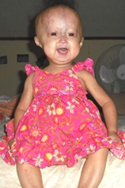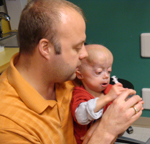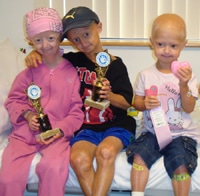The Progeria Research Foundation and Children’s Hospital Boston are once again partnering to conduct a second clinical trial for children with Progeria. This exciting and much larger trial includes 45 children from 24 countries, speaking 17 different languages!
Summary: Researchers have identified two additional drugs that, when used in combination with the current FTI drug being tested, may provide an even more effective treatment for children with Progeria than FTI’s alone.
Scientific Basis for Treatment
Progeria is caused by an abnormal protein named progerin. The Progeria research team at Children’s Hospital Boston will add two drugs, called pravastatin and zoledronate, to the current treatment with FTI.
Strategy: All three drugs will target different points along the pathway leading to production of the disease-causing progerin. In exciting laboratory studies presented by Dr. Carlos Lopez-Otin of Spain at the 2007 Progeria Research Foundation Scientific Workshop, the two new drugs improved disease in Progeria cells and extended lifespan in mouse models of Progeria.
Goal: If the three drugs administered in this trial can effectively block this farnesyl group attachment, then progerin may be “paralyzed” and Progeria may be improved. We hope that the drugs will work as partners, to complement each other so that the progerin protein is affected more by combining the three drugs than using any one drug alone.
Who is Enrolled in the Triple Drug Trial?
The Feasibility Trial: The team has already conducted a mini-trial for 5 children with Progeria. The short, one month “feasibility” trial, asked whether the three-drug combination would be well-tolerated, prior to embarking on a larger international trial. Side effects were acceptable, and the team has moved ahead to the larger efficacy trial.
The Efficacy Trial: In Janaury 2010, the triple trial beamce fully enrolled with 45 children. This includes children participating in the FTI-only trial, the 5 in the feasibility trial, and other children that were either too young to participate in the first trial or children that we’ve discovered over the past 2 years. Children enrolled in the FTI-only trial had the opportunity to enroll in the triple trial when they arrived for that first trial. This allowed the children to continue taking FTI without any missed doses.
The Treatment/Progeria Relationship
How did we get from gene discovery to drug therapy for children with Progeria? Finding the gene for Progeria was the key. This gene is called LMNA, and it normally encodes a protein called prelamin A (this protein is further processed and becomes lamin A). Children with Progeria have a mutation in LMNA which leads to the production of an abnormal form of prelamin A called “progerin.” Many years’ worth of basic research on prelamin A and lamin A gave us the ability to understand that the drugs administered in this trial may affect disease in Progeria. Over the past six years, research has focused on systematically testing these drugs on Progeria cells and Progeria mice.
The Clinical Trial Team
Since May 2007, a 28-member team has treated children with Progeria from around the globe. Members of the team have expertise not only in Progeria, but also in the three drugs administered in this trial.
Trial Medications at a Glance
Pravastatin (marketed as Pravachol or Selektine) is a member of the drug class of statins. It is usually used for lowering cholesterol and preventing cardiovascular disease.
Zoledronic acid is a bisphosphonate, usually used as a bone drug for improving osteoporosis, and to prevent skeletal fractures in people suffering from some forms of cancer.
Lonafarnib is an FTI (Farnesyltransferase inhibitor), a drug that can reverse an abnormality in Progeria cells in the laboratory, and has improved disease in Progeria mice.
All 3 drugs block the production of the farnesyl molecule that is needed for progerin to create disease in Progeria.
Timing
Patients are traveling to Boston for testing and examinations lasting 4-7 days, every 6 months for a period of 2 years. For the FTI-only trial, Boston visits occurred every four months.
Cost
Of course, a clinical trial of this magnitude is expensive to manage, and there are precious few sources of support for rare disease research. But in October 2009, the NIH’s National Heart, Lung, and Blood Institute awarded the triple trial team a prestigious “Grand Opportunities” grant that will cover many of the costs. We are thrilled to have earned this extraordinary support from NIH.
However, the grant doesn’t cover all of the trial expenses. PRF still needs to raise about $150,000 for some costs not covered by the grant.
Click here to donate to the triple drug trial and help make the GOAL of treatment and cure a REALITY!
* “Combined treatment with statins and aminobisphosphonates extends longevity in a mouse model of human premature aging”, by Ignacio Varela, Sandrine Pereira, Alejandro P. Ugalde, Claire L. Navarro, Marıa F. Suarez, Pierre Cau, Juan Cadinanos, Fernando G. Osorio, Nicolas Foray, Juan Cobo, Felix de Carlos, Nicolas Levy, Jose MP Freije and Carlos Lopez-Otın. Nature Medicine, 2008. 14(7): p. 767-72.
The new generation of children PRF is helping…
In March, 2009, five children, ages 2-3, participated in a one-month feasibility study to determine if the side effects of the three drugs taken together were tolerable. The results were positive, paving the way for the full, two-year, Triple Drug Trial to enroll up to 45 children with Progeria. Hats off to these amazing families!
Here is what some of them had to say:
 “EVERYONE has been so wonderful. To us you are ALL GOD SENT and we APPRECIATE all that you do for these little angels. Our family is so overwhelmed with excitement and all sorts of emotions with Adalia’s trip to Boston this weekend, I can’t even begin to type the words of how we are feeling”.
“EVERYONE has been so wonderful. To us you are ALL GOD SENT and we APPRECIATE all that you do for these little angels. Our family is so overwhelmed with excitement and all sorts of emotions with Adalia’s trip to Boston this weekend, I can’t even begin to type the words of how we are feeling”.
 “This new medication for Zach gives us a renewed hope that his heart will be stronger, his smile will be brighter and his life will be longer. This new drug trial is an answer to our prayers. Thank you to everyone involved with PRF who made this happen…the doctors, the researchers and the staff. You are our heroes!”
“This new medication for Zach gives us a renewed hope that his heart will be stronger, his smile will be brighter and his life will be longer. This new drug trial is an answer to our prayers. Thank you to everyone involved with PRF who made this happen…the doctors, the researchers and the staff. You are our heroes!”

Cam and his dad learn how to mix the FTI drug with a sweetener.
“On behalf of Cam and our family, thank you all at PRF so much for all you have done! We would have been lost in a world of confusion and grief without you. Instead, we live in a world of hope and purpose. Thank you again and again! With much love and respect,”

 “EVERYONE has been so wonderful. To us you are ALL GOD SENT and we APPRECIATE all that you do for these little angels. Our family is so overwhelmed with excitement and all sorts of emotions with Adalia’s trip to Boston this weekend, I can’t even begin to type the words of how we are feeling”.
“EVERYONE has been so wonderful. To us you are ALL GOD SENT and we APPRECIATE all that you do for these little angels. Our family is so overwhelmed with excitement and all sorts of emotions with Adalia’s trip to Boston this weekend, I can’t even begin to type the words of how we are feeling”. “This new medication for Zach gives us a renewed hope that his heart will be stronger, his smile will be brighter and his life will be longer. This new drug trial is an answer to our prayers. Thank you to everyone involved with PRF who made this happen…the doctors, the researchers and the staff. You are our heroes!”
“This new medication for Zach gives us a renewed hope that his heart will be stronger, his smile will be brighter and his life will be longer. This new drug trial is an answer to our prayers. Thank you to everyone involved with PRF who made this happen…the doctors, the researchers and the staff. You are our heroes!”

